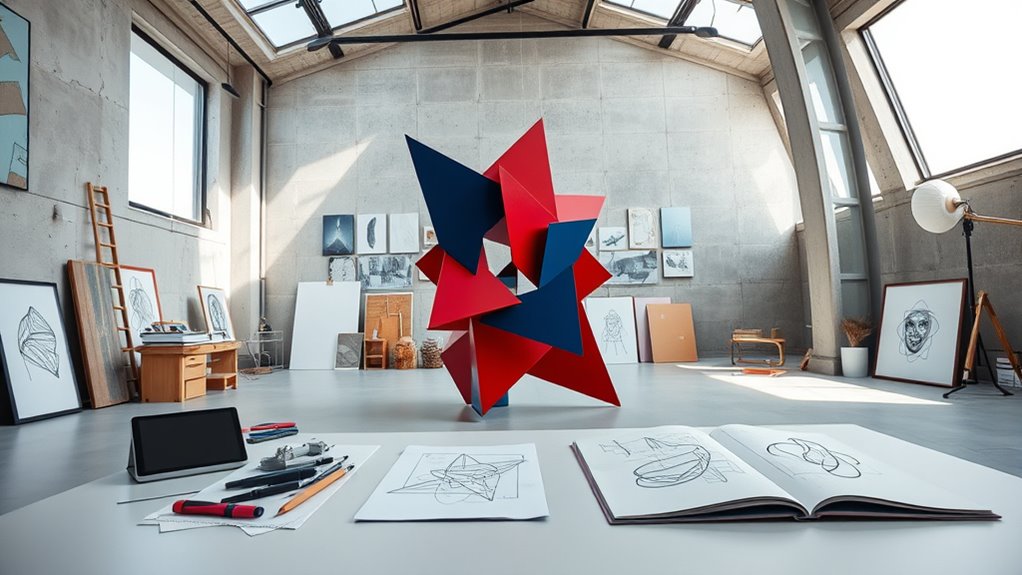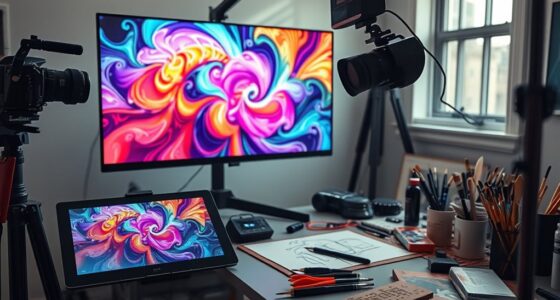Creative constraints in art and design push you to innovate within limitations, turning challenges into opportunities for breakthrough ideas. Case studies show that artists and designers often thrive when they work with strict parameters like limited palettes, budgets, or spaces. These boundaries encourage experimentation, resourcefulness, and fresh perspectives, leading to extraordinary work. By exploring these examples, you’ll discover how constraints can markedly elevate your own creative process and inspire new approaches. Keep going to uncover these inspiring strategies.
Key Takeaways
- Case studies highlight how artists and designers leverage strict parameters to foster innovation and resourcefulness.
- Examples include minimalist art, limited color palettes, and small-space murals that demonstrate creative problem solving.
- Boundary pushing techniques often involve experimenting with new materials or methods within defined constraints.
- Constraints in case studies reveal how focusing on essentials can lead to impactful, distinctive work.
- Effective use of limitations inspires unique solutions and redefines traditional norms in art and design projects.

Creative constraints might seem like limitations at first, but they can actually ignite innovation and focus your efforts. When you set boundaries, you force yourself to think differently, often leading to breakthrough ideas. Constraints challenge you to find unique solutions, pushing the limits of conventional thinking. This is where boundary pushing techniques come into play, inspiring innovative problem solving that might not have emerged in unrestricted environments. For example, artists and designers often work within strict parameters—such as limited color palettes, small spaces, or specific themes—and yet, they produce work that’s extraordinary. These restrictions compel you to explore new techniques, leverage resources creatively, and approach problems from fresh angles.
In art and design, creative constraints act as catalysts for originality. Take the case of a muralist who must work with a tight budget and limited materials. Instead of viewing these as obstacles, they use them to fuel inventive problem solving. They might repurpose discarded objects or incorporate minimalist elements that emphasize form and color. This boundary pushing technique not only makes the project feasible but also adds a distinctive character to the artwork. Similarly, in graphic design, restrictions like font choices or space limitations can inspire innovative solutions that make messages clearer and more impactful. Constraints push you to prioritize essentials, honing your focus and refining your vision.
In fashion design, working within specific themes or sustainability guidelines forces designers to think outside the box. A designer constrained by eco-friendly materials might discover new fabric blends or construction methods, leading to original collections that stand out. These boundary pushing techniques create opportunities for experimentation—challenging norms and redefining standards. Constraints also foster collaboration; when you’re limited in resources, you often turn to teamwork, pooling diverse skills and perspectives to solve problems creatively.
Ultimately, embracing creative constraints allows you to hone your skills and develop a sharper, more innovative mindset. Instead of seeing limitations as setbacks, view them as frameworks that inspire boundary pushing techniques. These constraints sharpen your focus and drive you to innovate, often resulting in work that’s not only resourceful but also uniquely yours. This approach doesn’t restrict your creativity—it channels it, encouraging you to discover solutions that might never have surfaced without those boundaries. When you leverage constraints effectively, you unlock a powerful method for creative problem solving that can elevate your art or design projects to new heights.
Frequently Asked Questions
How Do Constraints Influence Long-Term Artistic Innovation?
Constraints shape your long-term artistic innovation by pushing you to explore experimental boundaries you might not otherwise consider. They act as innovation catalysts, forcing you to think creatively within limits and discover new methods or styles. Instead of hindering, constraints challenge you to adapt and evolve, leading to breakthroughs that define your unique artistic voice over time. Embracing these limits can release unexpected creativity and sustain your growth as an artist.
What Are the Psychological Effects of Creative Limitations on Artists?
Creative limitations are like a double-edged sword; they challenge you but can also sharpen your skills. When faced with constraints, you develop creative resilience, pushing you to find innovative solutions. This process impacts your emotional state, often boosting confidence when you succeed and fostering growth through perseverance. While constraints may feel restrictive, they can deepen your emotional impact and inspire deeper artistic expression over time.
Can Constraints Hinder Originality or Promote It?
Constraints can both hinder and promote originality. While they may act as innovation barriers, limiting your creative freedom, they can also push you to think differently, fostering unique solutions. You might feel originality suppression at first, but over time, these limitations challenge you to innovate within boundaries, leading to fresh perspectives. Embracing constraints can spark creativity, turning perceived barriers into opportunities for original expression.
How Do Cultural Differences Shape Creative Constraints?
Did you know that over 60% of artists cite cultural norms as key influences on their work? Cultural differences shape creative constraints by defining artistic boundaries rooted in tradition, values, and societal expectations. These norms can either challenge you to innovate within or push you beyond existing boundaries. Embracing cultural diversity helps you see how artistic boundaries are fluid, encouraging originality while respecting unique cultural contexts.
What Role Do Constraints Play in Collaborative Art Projects?
In collaborative art projects, constraints shape your creative process by guiding your decisions and fostering teamwork. They influence collaborative dynamics, encouraging members to communicate effectively and compromise. Constraints also help you develop a shared vision, ensuring everyone’s ideas align toward a common goal. By working within limitations, you push your creativity further and create more cohesive, innovative art that reflects the collective effort.
Conclusion
You see, creative constraints are like the sculptor’s chisel—shaping raw material into breathtaking art. They are the guiding stars in your night sky, illuminating your path when inspiration flickers. Embrace these boundaries as your canvas’s frame, pushing you to innovate within limits. With each challenge, you forge resilience, transforming restrictions into vibrant brushstrokes of ingenuity. In constraints, you find the freedom to create masterpieces that echo with purpose and brilliance.









